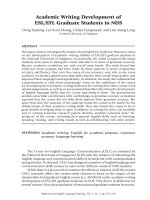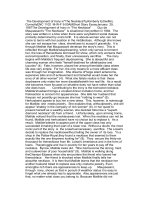DEVELOPMENT OF MICRO MODULAR THERMOPHOTOVOLTAIC POWER GENERATOR
Bạn đang xem bản rút gọn của tài liệu. Xem và tải ngay bản đầy đủ của tài liệu tại đây (7.27 MB, 222 trang )
DEVELOPMENT OF MICRO MODULAR
THERMOPHOTOVOLTAIC POWER GENERATOR
JIANG DONGYUE
(B. Eng, M. Eng, Dalian University of Technology)
A THESIS SUBMITTED
FOR THE DEGREE OF DOCTOR OF PHILOSOPHY
DEPARTMENT OF MECHANICAL ENGINEERING
NATIONAL UNIVERSITY OF SINGAPORE
2015
DECLARATION
I hereby declare that the thesis is my original work and it has been written by me in its
entirety. I have duly acknowledged all the sources of information which have been
used in the thesis.
This thesis has also not been submitted for any degree in any university previously.
Zeng Zeng
JIANG DONGYUE
28 MAY 2015
iii
Acknowledgements
I would like to extend my sincere thanks to my supervisor, Dr. Yang
Wenming from the Department of Mechanical Engineering, for his helpful
guidance, constant encouragement and advice on my research project. I have been
extremely lucky to have a supervisor who cares so much on my work, and who
responds to my questions and queries so promptly. Meanwhile, he gives me
enough space for inspiring my own thinking on the project. Because of his great
support, I can make the long and tough journey enjoyable.
I also express my sincere appreciation to my co-supervisors, Dr. Chua
Kian Jon from the Department of Mechanical Engineering, Prof. Ouyang
Jianyong from the Department of Materials Science and Engineering and Prof.
Teng Jinghua from the Institute of Materials Research and Engineering (IMRE).
Their helpful advice allowed me to resolve the difficulties in the multidisciplinary
project smoothly.
I am grateful to the lab officers, Mr. CHEW and Mrs. ANG (from Thermal
process lab 1) for their kind assistance in the micro-combustion experiment. I am
also grateful to the scientist, Dr. LIU Yan Jun and specialists, Mr. ANG Soo Seng,
iv
Mr. CHUM Chan Choy and Mr. WU Qing Yang from IMRE for the fabrication
and testing of the selective emitter.
I deeply acknowledge China Scholarship Council for the financial support.
Last but not least, I take this opportunity to express my deepest gratitude
to my family including my parents and my wife for their unfailing love,
unconditional sacrifice and steadfast support which are far more than I could ever
hope for.
Jiang Dongyue
v
Table of Contents
Acknowledgements iii
Summary ix
List of Tables xii
List of Figures xii
List of Symbols xvii
Chapter 1: Introduction 1
1.1 Micro-thermophotovoltaic (TPV) system 1
1.2 Literature review 5
1.1.1 Optimization of micro-combustors 6
1.1.2 Optimization of frequency selective filters/emitters 23
1.1.3 Development of low bandgap and high efficiency PV cell 41
1.3 Summary of research gaps 45
1.4 Purposes of this study 46
1.5 Significance 47
1.6 Organization of the thesis 48
Chapter 2: Analysis on The Micro Cylindrical Combustor with H
2
/CO Blended
Fuel 51
2.1 Introduction 51
2.2 Numerical model 52
2.3 Results and Discussion 57
2.3.1 Validation 57
2.3.2 Effects of flow velocity 59
2.3.3 Effects of tube length and wall thickness 65
2.4 Conclusion of this chapter 69
vi
Chapter 3: Development of Micro Planar Combustor with Baffles 71
3.1 Introduction 71
3.2 Methodology 71
3.2.1 Numerical model 71
3.2.2 Experimental setup 77
3.3 Results and Discussion 79
3.3.1 Geometric parameter optimization 79
3.3.2 Effects of flow velocity 83
3.3.3 Effects of H
2
/air equivalence ratio 89
3.3.4 Performance in the micro-TPV system 93
3.4 Conclusion of this chapter 95
Chapter 4: Second-Law Analysis of Fuel Lean Premixed H
2
/CO/air Flames and
The Combustion in Planar Combustor with Baffles 98
4.1 Introduction 98
4.2 Numerical approach 100
4.2.1 Computational domain 100
4.2.2 Entropy transport equation 101
4.3 Results and Discussion 104
4.3.1 Entropy generation induced by chemical reaction in H
2
/CO/air flame
104
4.3.3 Entropy generation induced by thermal conduction in H
2
/CO/air flame
111
4.3.4 Entropy generation induced by mass diffusion in H
2
/CO/air flame 116
4.3.5 Total entropy generation rate and exergy efficiency 120
4.3.6 Effects of inlet flow velocity on entropy generation in planar combustor
with baffles 121
vii
4.3.7 Effects of equivalence ratio 126
4.4 Conclusion of this chapter 128
Chapter 5: The Development of Wideband and Angle Insensitive Filter 130
5.1 Introduction 130
5.2 Numerical and experimental approach 131
5.3 Results and Discussion 134
5.3.1 Tunable filter 134
5.3.2 Wideband and angle-insensitive filter 137
5.3.3 Micro-TPV system with metamaterial filter 141
5.4 Conclusion of this chapter 146
Chapter 6: Development of Frequency Selective Emitter/Absorber Based on
Refractory Metamaterials 148
6.1 Introduction 148
6.2 Numerical and experimental approach 149
6.3 Results and Discussion 150
6.3.1 Dielectrics encapsulated TiN nanocavities 150
6.3.2 Performance at elevated temperatures and varied incidence angles 159
6.4 Conclusion of this chapter 161
Chapter 7: Performance of the Optimized Micro-TPV System with Cylindrical
Combustor Fueled by H
2
/CO/air, Planar Combustor with Baffles, Wideband Filter
and Selective Emitter 162
7.1 Introduction 162
7.2 Numerical approach 162
7.3 Results and Discussion 166
7.3.1 Effects of fuel mass flow rate 166
viii
7.3.2 Effects of CO addition 170
7.4 Conclusion of this chapter 171
Chapter 8: Conclusion and Future Work Recommendation 173
8.1 Summary of the thesis 173
8.2 Recommendations for future work 177
References 182
Appendix A: Uncertainty of the infrared thermometer for combustor wall
temperature measurement 197
Appendix B List of publications during Ph.D study 199
ix
Summary
Micro-thermophotovoltaic (TPV) power generator is a promising energy
conversion system for its superior features such as high energy density and free of
moving parts. The system is composed of a micro-combustor, filter and PV cells,
and the overall efficiency is limited by the efficiency of each component. As such,
it is essential to increase the efficiency of all the three components. In this work,
theoretical, numerical and experimental studies were carried out to obtain a
micro-combustor with high wall temperature, high-uniformity and high efficiency.
A novel selective filter and an innovative refractory frequency emitter were
developed.
A micro cylindrical combustor fueled by H
2
/CO/air blended fuel (Chapter
2) was first investigated: the effects of the combustor sizes (combustor length and
wall thickness) and operating conditions (inlet flow velocity and CO mass
fraction) on the wall temperature distribution and radiation power were
numerically investigated. Micro planar combustor is favorable for the micro-TPV
system due to its higher view factor. A micro planar combustor with baffles was
developed (Chapter 3). The baffles in the planar combustor were utilized for
x
recirculating the hot reacting gas. The effect of dimensionless height of the baffles
and the distance between them on the combustion process were analyzed
numerically. After obtaining the optimal dimensionless height and the distance
between the two baffles, a micro planar combustor was fabricated and tested. For
the first time, the Second-Law analysis was employed to investigate the entropy
generation caused by various factors in the micro cylindrical combustor fueled by
the H
2
/CO blended fuel and the micro planar combustor with baffles (Chapter 4).
Upon the optimization and analysis on the micro cylindrical combustor
and planar combustor, a novel metamaterial frequency selective filter was
designed and fabricated (Chapter 5). The filter which possessed the feature of
wide passband and angle-insensitive which was favorable to enhance the spectral
efficiency of the micro-TPV system.
For the first time, an innovative, robust, refractory frequency selective
emitter based on titanium nitride (TiN) was designed, fabricated and optimized
for further increase the spectral efficiency (Chapter 6). The developed selective
emitter was perfect for the application in the micro-TPV system with diverse PV
cells.
xi
In summary, the present study which includes the design and optimization
on the micro-combustors, filters and frequency selective emitters paves the way to
a high performance micro-TPV system.
xii
List of Tables
Table 1-1 Combustor wall temperature obtained from literature 14
Table 1-2 Summary of the reported selective emitters 40
Table 1-3 Low bandgap polymers 45
Table 2-1 Mass flow rates of H
2
, CO and air (
in
U
=2 m/s) 60
Table 7-1 System effciency comparison 170
Table A-1 Uncertainty in combustor wall temperature measurement…… ………… 196
List of Figures
Figure 1.1 Schematic of micro-TPV system 4
Figure 1.2 Spectral radiance of blackbody emitter at 1000 K and quantum efficiency of
the InGaAsSb PV cell 5
Figure 1.3 Effects of the increase of the emitter wall temperature 7
Figure 1.4 (a) Configuration and size of the micro-emitter with heat recirculation (b)
Schematic of combustion and flow direction of emitter with heat recirculation 10
Figure 1.5 Schematic of micro Swiss-roll structure 11
Figure 1.6 Schematic of micro-combustor with heat recuperation 13
Figure 1.7 Schematic of micro cylindrical combustor with nitrogen sealed tube 14
Figure 1.8 Schematic of micro-channel with catalysts segmentation and cavities 16
Figure 1.9 Micro-combustor with catalytic sticks 17
Figure 1.10 Schematic of the micro-combustor with two parts 18
Figure 1.11 Unutilized radiation energy for the normal emitters 24
Figure 1.12 The modeling of the heat transfer between heat source with filter and the PV
cell 25
Figure 1.13 Transmittance of the filter designed by modified quarter-wave stack 26
Figure 1.14 Reflectance of the filter with 9 layers 27
Figure 1.15 Radiation profiles of blackbody, broadband emitter and ideal emitter 28
Figure 1.16 Cross-section of the VERTE 29
Figure 1.17 Emittance of VERTE made with Tungsten and planar Tungsten 30
Figure 1.18 Schematic of the high-efficiency thermophotovoltaic system 31
xiii
Figure 1.19 Predicted normal emittance of W PhC design I (r=0.45 µm, a=1.1 µm, d=1.5
µm), design II (r=0.55 µm, a=1.3 µm, d=2.1 µm), design III (r=0.625 µm, a=1.4 µm,
d=2.8 µm) and flat tungsten 32
Figure 1.20 Measured and predicted W PhC selective emitter, flat W and blackbody 32
Figure 1.21 Schematic of the dielectrics filled cavity structure 34
Figure 1.22 Schematic of the high performance thermophotovoltaic system with tantalum
photonic crystal selective emitter and filter 36
Figure 1.23 Emittance over wavelength and polar angle for a pure photonic crystal
structure (a) and HfO
2
filled photonic crystal structure (b) 36
Figure 1.24 Schematic of metallic photonic crystal selective absorber-emitter for solar-
TPV 38
Figure 1.25 Spectral active-area absolute external quantum efficiency data for Ga
x
In
1-x
As
TPV converters [79] 43
Figure 2.1 Schematic of micro cylindrical combustor 53
Figure 2.2 Grid independency test 57
Figure 2.3 Wall temperature profiles from the two reaction mechanisms and experiment
at =1.0, = 1m/s (a), = 2 m/s (b) and = 3 m/s (c) 59
Figure 2.4 (a) gas temperature along the centerline (
in
U
= 2 m/s), (b) gas temperature
along the centerline (
in
U
=2.5 m/s), (c) local heat release rate along the centerline (
in
U
=
2 m/s), (d) local heat release rate along the centerline (
in
U
=2.5 m/s), (e) radiated power
along the emitter wall (
in
U
=2.5 m/s) 61
Figure 2.5 (a) gas temperature along the centerline (
in
U
=3 m/s), (b) local heat release
rate along the centerline (
in
U
=3 m/s), (c) radiated power along the wall (
in
U
=3m/s) and
(d) emitter efficiency 65
Figure 2.6 (a) radiated power profiles along the emitter with the length of 16 mm, (b)
radiated power profiles along the emitter with the length of 20 mm, (c) radiated power
profiles along the emitter with the wall thickness of 0.4 mm and (d) radiated power
profiles along the emitter with the wall thickness of 0.6 mm 67
Figure 2.7 (a) Emitter efficiency varying with emitter length and CO mass fraction (b)
emitter efficiency varying with wall thickness and CO mass fraction 69
xiv
Figure 3.1 (a) schematic of the micro-combustor with baffles and (b) the real photos of
the fabricated micro planar combustor 74
Figure 3.2 Velocity distribution inside the micro-combustor with baffles 76
Figure 3.3 Mesh independency study 77
Figure 3.4 Experimental setup of the micro-combustion system 79
Figure 3.5 Experimental validation on the numerical result (
in
U
=6 m/s,
=1,
=0.7 and
=0.45) 80
Figure 3.6 Temperature distribution on combustor wall with respect to
(
=1.0,
=0.7)
82
Figure 3.7 Temperature distributions on combustor wall with respect to
(
=1.0,
=0.45) 83
Figure 3.8 Measured combustor wall temperature distributions of (a)
in
U
=3 m/s,
3
h
=6
mm, (b)
in
U
=3 m/s,
3
h
=4.5 mm, (c)
in
U
=3 m/s,
3
h
=1.5 mm, (d)
in
U
=6 m/s,
3
h
=6 mm,
(e)
in
U
=6 m/s,
3
h
=4.5 mm and (f)
in
U
=6 m/s,
3
h
=1.5 mm at equivalence ratio
=1.0 . 86
Figure 3.9 Predicted velocity magnitude distribution in the combustors with (a)
3
h
=6 mm,
(b)
3
h
=4.5 mm and (c)
3
h
=1.5 mm at equivalence ratio
=1.0 and velocity
in
U
=6 m/s 86
Figure 3.10 Variance and combustor efficiency of the combustors with different insertion
length (
3
h
) and inlet velocity (
in
U
) 89
Figure 3.11 Measured combustor wall temperature distributions of (a)
=0.8,
3
h
=6 mm,
(b)
=0.8,
3
h
=4.5 mm, (c)
=0.8,
3
h
=1.5 mm, (d)
=1.2,
3
h
=6 mm, (e)
=1.2,
3
h
=4.5
mm and (f)
=1.2,
3
h
=1.5 mm at velocity
in
U
=6 m/s 92
Figure 3.12 Mass fraction distribution of H
2
at
=0.8 and
=1.2 92
Figure 3.13 Variance and combustor efficiency of the combustors with different insertion
length (
3
h
) and equivalence ratio (
) 93
Figure 3.14 (a) Experimental photo of the optimal condition, (b) Schematic of the micro-
TPV and (c) Spectral radiance of the planar combustor 95
Figure 4.1 Schematic of the micro channel 101
Figure 4.2 Contribution rates of the most-contributing reactions with the CO mass
fraction of 0 (a), 10% (b), 15% (c) and 20% (d) 106
xv
Figure 4.3 Volumetric entropy generation due to chemical reaction, (a) CO mass fraction
=0, (b) CO mass fraction = 10%, (c) CO mass fraction =15% and (d) CO mass fraction
=20%,
in
U
=3 m/s 108
Figure 4.4 Volumetric entropy generation induced by chemical reaction (a) CO mass
fraction =0, (b) CO mass fraction = 10%, (c) CO mass fraction =15% and (d) CO mass
fraction =20%,
in
U
=2 m/s 109
Figure 4.5 Volumetric entropy generation induced by chemical reaction (a) CO mass
fraction =0, (b) CO mass fraction = 10%, (c) CO mass fraction =15% and (d) CO mass
fraction =20%,
in
U
=3 m/s 110
Figure 4.6 Entropy generation rates due to chemical reaction (CO mass fraction varies
from 0 to 20% and flow velocity varies from 1 to 3 m/s) 110
Figure 4.7 Volumetric entropy generation induced by thermal conduction (a) CO mass
fraction =0, (b) CO mass fraction = 10%, (c) CO mass fraction =15% and (d) CO mass
fraction =20%,
in
U
=1 m/s 113
Figure 4.8 Volumetric entropy generation induced by thermal conduction (a) CO mass
fraction =0, (b) CO mass fraction = 10%, (c) CO mass fraction =15% and (d) CO mass
fraction =20%,
in
U
=2 m/s 114
Figure 4.9 Volumetric entropy generation induced by thermal conduction (a) CO mass
fraction =0, (b) CO mass fraction = 10%, (c) CO mass fraction =15% and (d) CO mass
fraction =20%,
in
U
=3 m/s 115
Figure 4.10 Entropy generation rates induced by thermal conduction (CO mass fraction
varies from 0 to 20% and flow velocity varies from 1 to 3 m/s) 115
Figure 4.11 Volumetric entropy generation induced by mass diffusion (a) CO mass
fraction =0, (b) CO mass fraction = 10%, (c) CO mass fraction =15% and (d) CO mass
fraction =20%,
in
U
=1 m/s 117
Figure 4.12 Volumetric entropy generation induced by mass diffusion (a) CO mass
fraction =0, (b) CO mass fraction = 10%, (c) CO mass fraction =15% and (d) CO mass
fraction =20%,
in
U
=2 m/s 118
Figure 4.13 Volumetric entropy generation induced by mass diffusion (a) CO mass
fraction =0, (b) CO mass fraction = 10%, (c) CO mass fraction =15% and (d) CO mass
fraction =20%,
in
U
=3 m/s 119
xvi
Figure 4.14 Entropy generation rates induced by mass diffusion (CO mass fraction varies
from 0 to 20% and flow velocity varies from 1 to 3 m/s) 119
Figure 4.15 Total entropy generation rates and exergy efficiency (CO mass fraction
varies from 0 to 20% and flow velocity varies from 1 to 3 m/s) 121
Figure 4.16 Volumetric entropy generation rate distribution caused by chemical reaction
at different mass flow rates. (Equivalence ratio=1.0, W/m
3
K) 124
Figure 4.17 Volumetric entropy generation rate distribution caused by thermal
conduction at different mass flow rates. (Equivalence ratio=1.0, W/m
3
K) 124
Figure 4.18 Volumetric entropy generation rate distribution caused by mass diffusion at
different mass flow rates. (Equivalence ratio=1.0, W/m
3
K) 125
Figure 4.19 Entropy generation rates and exergy efficiency with mass flow rates 125
Figure 4.20 Volumetric entropy generation rate distribution caused by chemical reaction
at different equivalence ratios. (Mass flow rate=50 g/h for each inlet, W/m
3
K) 127
Figure 4.21 Entropy generation rates and exergy efficiency at different equivalence ratios
127
Figure 5.1 Black body (black line) and reactor (yellow line) spectral radiance, as well as
the ideal filter transmission performance (green line) 132
Figure 5.2 (a) schematic of the micro-TPV system with the metamaterial filter. (b)
isometric and (c) top view of one unit cell of the coaxial ring structure, with metal
thickness t, inner radius r
1
, outer radius r
2
and period p 133
Figure 5.3 Transmittance (a) and reflectance (b) of coaxial ring array with period of 600
nm (t= 50 nm, r
1
= 100 nm, r
2
= 220 nm) and 900 nm (t= 50 nm, r
1
= 140 nm, r
2
= 360 nm).
Inset of (a) are the SEM images of the designs with 600 nm (top) and 900 nm (bottom)
periods 136
Figure 5.4 Measured transmittance and reflectance of coaxial ring arrays with r
1
of 140
nm (t= 50 nm, r
2
= 360 nm, p= 900 nm) and 160 nm (t=50 nm, r
2
=360 nm, p=900nm),
respectively 137
Figure 5.5 Predicted transmittance (a) and reflectance (b) of the samples with different
metal thicknesses t=250, 300, 350 and 400 nm, respectively 139
Figure 5.6 Measured and predicted average transmittance at FWHM varying with
different incidence angles. (t=50 nm, r
1
=80 nm, r
2
=220 nm, p=600 nm) 140
xvii
Figure 5.7 Energy conversion process of micro-TPV system with the metamaterial filter
142
Figure 5.8 Reactor wall temperature distributions at (a) 3 m/s, (b) 4 m/s and (c) 5 m/s.
(Case A, without filter; Cases B- D with filter and their reactor-filter distances are 1, 2
and 3 mm, respectively) 144
Figure 5.9 Predicted system efficiencies of micro-TPV system with different inlet flow
velocities for the four cases. (Case A, without filter; Case B, with filter and reactor-filter
distance 1 mm; Case C, with filter and reactor-filter distance 2 mm; Case D, with filter
and reactor-filter distance 3 mm) Lines connecting the symbols are only for sake of
visualization 146
Figure 6.1(a) schematic and (b) size of the dielectric encapsulated nanocavity, (c) SEM
image of the fabricated pure nanocavity and (d) measured and predicted
emissivity/absorptivity 155
Figure 6.2 Electric field distributions in the pure nanocavity (a-d) and SiO
2
encapsulated
nanocavity structure (e) and (f) at varied wavelengths 158
Figure 6.3 Emitter/absorber performance (a) after annealing at 1073 K for 2 hours and (b)
at varied incidence angles 160
Figure 7.1Schematic of the micro-TPV system with cylindrical combustor (a) and planar
combustor (b) 164
Figure 7.2 (a) system efficiency and (b) power output of the micro-TPV system 169
Figure 7.3 Effects of CO mass fraction on cylindrical combustor efficiency and power
output 171
Figure 8.1 Edge thermalization effect 178
Figure 8.2 Comparison of single peak and broadband selective emitter 178
Figure 8.3 Bandgaps of several PV cells 180
List of Symbols
A
surface area of the combustor wall, m
2
D
diameter of the micro cylindrical combustor, m
xviii
in
D
inner diameter of micro cylindrical combustor, mm
m
D
mass diffusion coefficient, m
2
/s
ndestructio
E
exergy destruction, W
in
E
exergy at inlet, W
loss
E
exergy loss, W
g
volumetric entropy generation rate, W/(m
3
K)
h
enthalphy, kJ/kg
1
h
height of combustor, mm
2
h
height of baffle, mm
3
h
connection tube insertion length, mm
c
H
lower heating value of hydrogen, MJ/kg
m
h
enthalphy of species m, kJ/kg
f
h
convective heat transfer coefficient, W/(m
2
K)
i
streamwise component
max
I
peak spectral radiance, W/((sr m
2
)/nm)
j
transverse component
ij
J
diffusion flux
k
thermal conductivity, W/(mK)
eff
k
effective thermal conductivity, W/(mK)
m
K
formation rate of the m th species per unit volume per unit time
t
k
turbulence kinetic energy
xix
L
length of combustor, mm
2
H
m
mass flow rate of hydrogen, kg/s
m
n
number density of species m
P pressure, Pa
P
pressure tensor
r
P
radiation energy, W/m
2
q
energy flux, W/m
2
loss
q
heat loss from the wall of the combustor, W
r
radial coordinate, m
gm
R
specific gas constant, J/(kgK)
i
R
net production rate of species
i
,kg/(m
3
s)
m
R
net rate of production of species m, kg/(m
3
s)
m
r
chemical reaction rate of species m
s
specific entropy, J/(kgK)
2
S
variance of temperature distribution
reactiongen
S |
volumetric entropy generation rate due to chemical reaction, W/(m
3
K)
conductiongen
S |
volumetric entropy generation rate due to thermal conduction,
W/(m
3
K)
diffusiongen
S |
volumetric entropy generation rate caused by mass diffusion, W/(m
3
K)
totalgen
S |
total entropy generation rate due to chemical reaction, W/K
h
S
source of energy caused by chemical reaction
t
wall thickness of the combustor, mm
xx
Dt
time derivative
T temperature, K
T
temperature gradient
0
T
dead state temperature, K
in
T
stream temperature, K
w
T
wall temperature of the combustor, K
T
ambient temperature, K
u
specific internal energy, J/kg
in
U
inlet flow velocity, m/s
i
u
,
j
u
,
z
u
velocity component, m/s
'
i
u
,
'
j
u
fluctuating velocity component, m/s
v
velocity tensor
V
volume of the channel, m
3
m
V
diffusion velocity of species m
i
x
,
j
x
,
z
x
cartesian coordinate, m
m
X
mole fraction of species m
m
X
mole fraction gradient of species m
m
Y
mass fraction of species m
m
Y
mole fraction gradient of species m
Greek symbols
s
Stefan-Boltzmann’s constant, W/(m
2
K
4
)
xxi
entropy flow
emissivity of the combustor wall
density, kg/m
3
ij
stress tensor, Pa
dimensionless distance between the baffles
ij
Kronecker delta
combustor
emitter efficiency
filter
filter efficiency
PV
PV cell efficiency
E
exergy efficiency
dimensionless heights of the baffles
T
turbulent viscosity
m
chemical potential, J/kg
equivalence ratio
Acronyms
TPV thermophotovoltaic
PV photovoltaic
FWHM full width at half maximum
LHV lower heating value
PMMA: Poly(methyl methacrylate)
xxii
FDTD: Finite-difference time-domain
1
Chapter 1: Introduction
1.1 Micro-thermophotovoltaic (TPV) system
The past decade has witnessed the fast development of micro and nano-
fabrication technologies. Such technologies have significantly accelerated the
miniaturization and multi-functionalization of micro-mechanical,
communicational, imaging, sensing, chemical analytical, and biomedical devices
[1]. These systems require a power source with the feature of portable, high
energy density, short charging time, longevity and environmental friendly.
Currently the dominant power sources for these systems are chemical batteries.
However, the energy density of the chemical batteries is quite low. Even the most
advanced lithium-ion battery only has an energy density of about 0.2 kWh/kg [2].
Besides, the chemical batteries also face the problem of long charging time and
limited rechargeable cycles. Moreover, the disposal of the chemical batteries
would cause various environmental issues. The adverse effects of chemical
batteries are behind the emergence of a new class of micro power sources [3]. The
need of high density power sources is expecting to further increase in future as
the enhanced functionalities of the electronic devices require more power [3].
2
Combustion-driven micro-scale power generators become attractive
technological alternatives to chemical batteries by taking the advantage of high
energy density of hydrogen and hydrocarbon fuels. The energy density of the
combustion-driven micro-scale power generators could be up to 12 kWh/kg [4],
which is much higher than the chemical batteries. Therefore, the key issue is to
convert the widely available chemical fuels into electricity efficiently and robustly
in a millimeter scale system [4]. In order to address the growing demand for small
scale and high energy density power sources, various combustion-driven micro
power generators are being developed around the world such as micro gas
turbines [5], micro Wankel engines [6], micro piezoelectric [7] and micro-TPV
power generation systems [8]. Different from other micro power generation
engines, the high surface to volume ratio of micro combustor/emitter is favorable
to achieve higher energy density for micro-TPV system.
Micro-TPV system is an advanced solid-state energy conversion system
[9]. As shown in Figure 1.1, the system is composed of micro combustor/emitter,
filter and low bandgap PV cells. The energy conversion process of the micro-TPV
system is: (i) in combustion process, the chemical energy from the hydrogen or
3
hydrocarbon fuels is converted into thermal energy, (ii) by the effects of thermal
conduction and convection, the thermal energy from the combustion is
transformed to the surface of the combustor/emitter as radiation energy, (iii) the
radiated photons with the wavelength shorter than the cut-off wavelength of the
filter is transmitted while those with the wavelength greater than the cut-off
wavelength is reflected, (iv) the transmitted photons impinge on the PV cell array
and evoke free electrons and produce electrical power output, and the reflected
photons are absorbed by the emitter wall to increase the temperature. In this
process, the radiated photons from the combustor wall with the wavelength
shorter than bandgap of the PV cell could be used for power generation. However,
the photons with a longer wavelength would be useless. That is why the filter is
employed. The cut-off wavelength of the filter is supposed to be the same as the
bandgap of the PV cells. By this mechanism, the micro-TPV system could be
employed to convert chemical energy into electricity. This system can be used to
recycle the waste thermal energy at high temperature such as the thermal energy
in high temperature furnaces. Besides the high power density, the micro-TPV
system also possesses the advantages of longevity and moving parts free.









